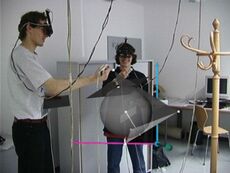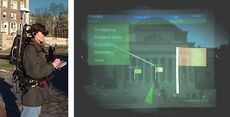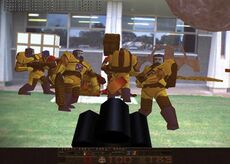Augmented reality
Augmented reality is a situation where there are virtual objects in the real world. Augmented reality can be done using an AR headset. If using a headset, the headset requires 3D tracking. Augmented reality can involve fiducial markers for tracking, such as ArUco markers.
To register the coordinate system to the environment, 6DOF tracking must be used. Tracking can be done optically (using fiducial markers or markerless SLAM), or by using magnetic tracking or lighthouse tracking.
Augmented reality can be see through or passthrough. See through uses an optical see through display like on the Magic Leap. Passthrough uses a camera feed and an optically opaque display, like a smartphone or a Meta Quest Pro.
Multi-user augmented reality has the potential to change conversation between two people. Two people, each with a pair of AR glasses, could both see a 3D model that one person is annotating.
Augmented reality can be done using a notebook computer. In this way, it does not need an absolute positioning system relative to the environment. It has an embedded coordinate system, such that there is a homotopy between the set of transforms in the real world coordinate system and the set of transforms in the embedded coordinate system of the notebook computer.
Technologies[edit]
See-through displays[edit]
See through displays have been used in gadgets like the Magic Leap 1 and the HoloLens 1 to overlay content onto the real world.
Augmented reality using headsets benefits from a high field of view and a high focal depth range. Focal depth range can be done using light field displays or holographic displays.
Environment tracking[edit]
Environment tracking is the capability of a gadget to know its position and orientation relative to its environment. This is required so that the virtual imagery has correct registration to the real world.
History[edit]
The historical development of AR technologies intersects with that of virtual reality. During the initial stages of its evolution, the terms augmented reality and virtual reality had not been coined and, consequently, there wasn’t a clear distinction between the two [1].
Professor Thomas P. Caudell, a researcher at Boeing, coined the term augmented reality. The term was in reference to a HMD that guided workers through assembling electrical wires in aircraft.[1][2][3]
Some of the first progress in augmented reality was from the aerospace industry: companies such as Boeing, Polhemus, Hughes Research Labs, and Kaiser.
Existing work[edit]
Ivan Sutherland's head-mounted display[edit]
Ivan Sutherland and Bob Sproull created a head-mounted display system at Harvard University and the University of Utah. The gadget has see-through optics and displayed simple wireframe graphics, and was held to the ceiling by a mechanical arm which tracked the head movements of the user. This iteration of the technology would prove to be impractical for mass use. Sutherland also postulated the concept of the “Ultimate Display” in the year G1965 and would have a great impact in the VR and AR fields of study [1][4][5][6][3].
Videoplace[edit]
The videoplace was developed by Myron Krueger. It was an interface that allowed users to manipulate and interact with virtual objects in real-time. It combined projectors, video-cameras and special purpose hardware, as well as onscreen silhouettes of the users.[1][2][4]
Virtual Fixtures[edit]
Virtual Fixtures is developed at USAF Armstrong’s Research Lab by Louis Rosenberg. According to some sources, it can be considered the first properly functioning AR system. It was a system that overlaid sensory information on a workspace to improve human productivity.[1]
KARMA[edit]
Feiner and colleagues introduced KARMA - Knowledge-based augmented reality for maintenance assistance. KARMA was capable of inferring instructions sequences for repair and maintenance procedures.[4]
During the same year, Fitzmaurice created the first handheld spatially aware display called Chameleon - a precursor to handheld AR. It consisted of a tethered handheld LCD screen that showed the video output of an SGI graphics workstation and was spatially tracked using a magnetic tracking device. The system was capable of providing information to the user such as providing information about a location on a wall-mounted map [4].
Studierstube[edit]
The first collaborative AR system was developed by Schmalstieg and colleagues. The Studierstube enabled multiple users to experience virtual objects in the same shared space through the use of HMDs. Each user from his individual viewpoint could see an image in correct perspective.[4]
The Touring Machine[edit]
Feiner and colleagues create the first outdoor AR system, at Columbia University. The Touring Machine (Figure 3) had a see-through HMD, GPS, and orientation tracking. The system needed a backpack with a computer to deliver mobile 3D graphics, various sensors, and an earlier version of a tablet computer for input.[4]
ARQuake[edit]
The AR version of the Quake game was developed by Bruce Thomas, at the University of South Australia. It was an outdoor mobile version of the game developed by Id Software.[2]
First autonomous handheld AR system[edit]
Wagner and Schmalstieg presented a handheld AR system that ran autonomously on a “personal digital assistant.” A multiplayer handheld AR game called Invisible Train (Figure 5) was shown at the SIGGRAPH Emerging Technologies show floor.[4]
A commercial AR application[edit]
The first commercial AR application is developed by German agencies in Munich for advertising. It consisted of a printed magazine ad of a model BMW mini. When held in front of a computer’s camera, a user could manipulate the virtual car on the screen and move it around to view different angles.[5][7] During the same year, the Wikitude AR Travel Guide was released for the G1 Android phone.[2]
ARToolkit[edit]
A design tool, ARToolkit, was made available in Adobe Flash.[1]
HoloLens[edit]
Microsoft announced the HoloLens.[1]
More[edit]
Pokémon Go was released and became a major success. It is mainly a geolocation based game, but has some AR features. The game hit almost 46 million users.
CREAL has advertised light field displays for augmented reality.
References[edit]
- ↑ 1.0 1.1 1.2 1.3 1.4 1.5 1.6 The Interaction Design Foundation. Augmented Reality - The past, the present and the Future. Retrieved from https://www.interaction-design.org/literature/article/augmented-reality-the-past-the-present-and-the-future
- ↑ 2.0 2.1 2.2 2.3 Sawers, P. (2011). Augmented reality: The past, present and future. Retrieved from https://thenextweb.com/insider/2011/07/03/augmented-reality-the-past-present-and-future/#.tnw_tfKQ6SY7
- ↑ 3.0 3.1 van Krevelen, D. W. F. (2007). Augmented Reality: Technologies, applications, and limitations. Retrieved from https://www.researchgate.net/profile/Rick_Van_Krevelen2/publication/292150312_Augmented_Reality_Technologies_Applications_and_Limitations/links/56ab2b4108aed5a01359c113.pdf
- ↑ 4.0 4.1 4.2 4.3 4.4 4.5 4.6 Hollerer, T. and Schmalstieg, D. (2016). Introduction to Augmented Reality. Retrieved from http://www.informit.com/articles/article.aspx?p=2516729
- ↑ 5.0 5.1 Javornik, A. (2016). The mainstreaming of augmented reality: A brief history. Retrieved from https://hbr.org/2016/10/the-mainstreaming-of-augmented-reality-a-brief-history
- ↑ Virtual Reality Society. History of Virtual Reality. Retrieved from https://www.vrs.org.uk/virtual-reality/history.html
- ↑ History Hole (2016). The history of augmented reality. Retrieved from http://historyhole.com/history-augmented-reality


